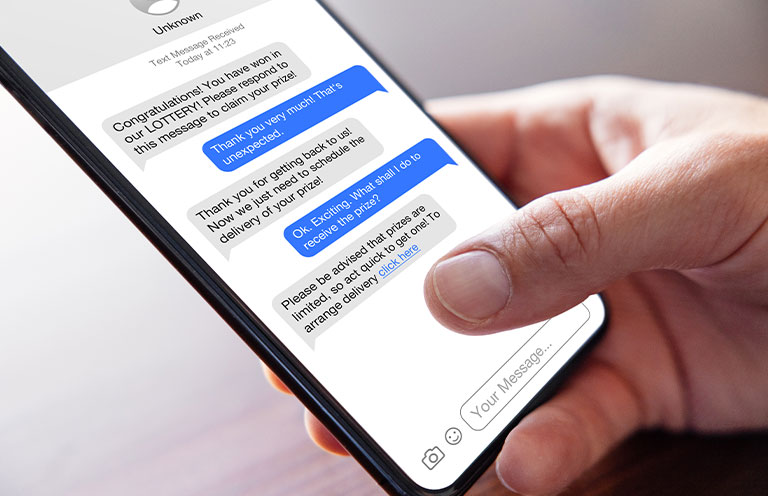5 Scams You Need to Know About in 2025
Scammers are using AI and social engineering to outsmart even cautious consumers. Here’s what you need to know to protect yourself


Spam calls have decreased in the past five years, according to a report from the Federal Trade Commission—but scam calls are on the rise. Not only are they becoming more frequent, but the scammers are getting smarter, too. Scammers are now utilizing artificial intelligence (AI), fake QR codes, and increasingly sophisticated social engineering tactics to steal billions from their victims. Here are the top scams to watch out for—and how you can protect yourself from getting scammed.

AI voice-cloning scams
Scammers are now using AI to clone voices, sometimes with just a few seconds of audio pulled from social media or voicemails. They’ll call victims pretending to be distressed family members, urgently requesting money transfers.
The “family emergency” scam has been around for a long time, but AI has made it harder to spot impersonators. In one high-profile case in Hong Kong, AI-generated deepfakes impersonating executives on Zoom calls convinced employees to transfer nearly $25 million. These scams rely on emotional manipulation to override logic and pressure people into acting quickly.
If you get requests that seem out of the ordinary, ask the person to verify their identity, and also verify their identity through other channels of communication as well. For example, if you get a social media message from your niece, call her cell phone to confirm that she sent the message.

QR code scams (quishing)
QR code phishing, also known as "quishing," is when criminals trick users into scanning malicious QR codes that direct them to fraudulent websites. Scammers sometimes place fake stickers over real QR codes on restaurant menus, parking meters, and public spaces.
Before opening a QR code link, check the printed web address near the QR code and inspect the sticker for signs of tampering or misplacement, advises digital forensics consultant Calum Baird.

Toll road payment scam texts
Smishing scams—a mashup of SMS (short message service) and phishing (attacks via email and the internet)— have exploded nationwide. One of the most common is the toll scam swindle in which scammers send texts claiming that you have unpaid toll fees.
According to Baird, these messages commonly include generic messaging with a lack of specific details and create "a sense of urgency, such as the alleged toll fee rising or being passed to debt collection imminently." The scammers use authentic-looking toll service names to trick victims into providing payment information on fake websites.
Always go directly to the source to verify any missed toll fees, says Baird. If you get a smishing text, look up the toll payment company online, and contact the email or phone number on its official website to confirm that you owe fees.

'Too good to be true' deals
Another increasingly common scam, especially on social media platforms, is the “too good to be true” deal, according to Baird. Scammers create fake advertisements offering high-demand products at unbelievably low prices. These ads often link to fraudulent websites that are designed to appear legitimate, complete with fake customer reviews to build trust. These scams are designed to take your money—and in some cases, your personal data—without delivering anything in return.
If a deal seems suspiciously cheap or the website feels off, it’s best to pause and do some research before entering any payment information. To determine if a website might be fraudulent, Baird recommends checking the age of the website and when the domain was created. Tools such as Who.Is can help with this. Scam websites are often short-lived, so if a site was recently launched and is offering extremely low prices, there’s a good chance it’s a fraudulent website.

Advanced targeted attacks
Not all scams use generic messaging. Baird warns that some are highly targeted—a criminal technique known as spearphishing. In these cases, cybercriminals use personal information, often obtained through data breaches, to craft convincing messages tailored to specific individuals.
"If a cybercriminal had access to the data held by a car rental company, they could craft a specific message with specific information about who was driving the car, what the registration of the car was, and claim that the alleged toll fee was on a date the car was in use," says Baird.
This level of detail makes the scam appear legitimate, increasing the chances the target will respond or act without verifying the source.
When receiving an urgent message, even if it seems highly personalized, contact the alleged sender through a method that you already know is true, advises Baird. This could be their office number or the number from their official website.
Stay vigilant to scams
While older adults are most often targeted—especially those who are very active on social media or online platforms—anyone can fall victim to a sophisticated scam. The best defense is developing verification habits: Pause if you’re feeling pressured, double-check through independent sources, and trust your instincts when something feels off.
If you do encounter a scam, report it to the FBI's Internet Crime Complaint Center (IC3) at ic3.gov to help protect yourself and others down the road.
